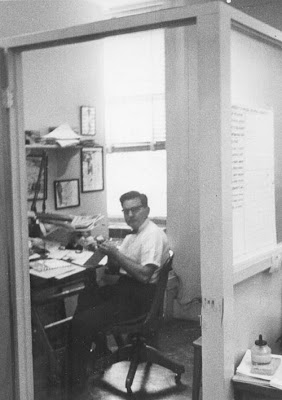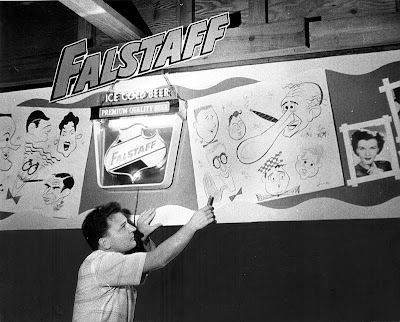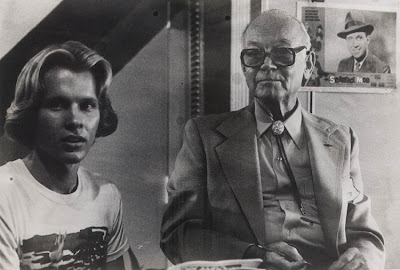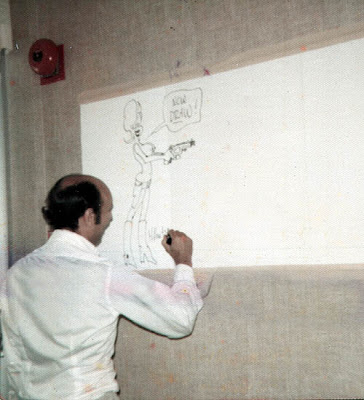Wednesday, February 07, 2007
Obscurity of the Day: Gahan Wilson Sunday Comics

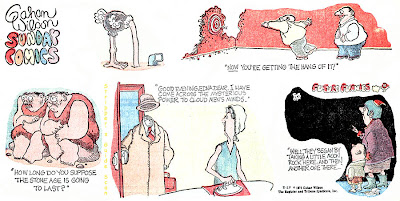
Magazine cartoonist Gahan Wilson, best known for his work in Playboy, branched out into the newspaper cartoon biz with the rather unimaginatively titled Gahan Wilson Sunday Comics feature. Marketed by the Iowa-based Register & Tribune Syndicate, the feature never caught on despite the obvious appeal of Wilson's wild artwork and off-kilter gags.
The feature began on March 3 1974 and succumbed on May 29 1977 (at least that's the last Sunday I have). When Wilson started the feature his pages included a mix of unrelated gags. About six months in, though, he switched over to having all the gags on a single subject.
Coming up with that many gags every week for the Sunday page in addition to his magazine work may have been a strain on Wilson but the end-product didn't seem to suffer. The Sunday page gags, while perhaps not all gems, had plenty of hits to compensate for the misses. As a bibliomaniac, my favorite of the Wilson Sunday pages is the first example shown here. The one with the giant book, especially, hits my funnybone.
There are lots of websites with interesting Gahan Wilson content, of which Wilson's own site is a good first stop. Here's one with a pretty decent bio, and here's an archived NPR interview with the cartoonist.
On a side note, Wilson's apparently all but forgotten National Lampoon cartoon series "Nuts" is, to me, by leaps and bounds Wilson's greatest work. It was collected in a long out of print book that is still available, though a bit pricey, on used book sites like ABE.
Labels: Obscurities
Comments:
"Gahan Wilson's Sunday Comics" was also reprinted in "Menomonee Falls Guardian" on issues 112 to 129.
I only have the M. Falls Guardian #1 to #26 and would love a complete set now that I can afford it. But it doesn't pop up regularely.
This is what I love about your blog: early 20th Century obscurities and then out of the blue it's Gahan Wilson from the seventies!
Hello, could you do a daily post on what books one should have in there collection pertaining to newspaper comics. Books that can be used for referencing or just for giving history and guidelines to collecting newspaper comics. preferably books for newspaper comics and not the original art. Finding books of this nature are hard to do and i thought you might have some leads. -Steve
Hi Steve -
My reference shelf, always in reach while I'm doing research, has the following standard references:
Encyclopedia of American Comics, Ron Goulart
The Funnies, Ron Goulart
The Adventurous Decade, Ron Goulart
World Encyclopedia of Comics, Maurice Horn
World Encyclopedia of Cartoons, Maurice Horn
100 Years of American Newspaper Comics, Maurice Horn
The Comics, Jerry Robinson
Comics And Their Creators, Martin Sheridan
The Comics, Coulton Waugh
A Century of Women Cartoonists, Trina Robbins
Women and the Comics, Robbins and Yronwode
The Compact History of the American Newspaper, Tebbell
American Journalism, Frank Luther Mott
Syndicated Comic Strips and Artists, Dave Strickler
Davenport's Art Reference & Price Guide
A History of Newspaper Syndicates in the United States, Elmo Scott Watson
King News, Moses Koenigsberg
.. and as soon as I get my copy, Here We Are Again by Alfredo Castelli.
None of these books is perfect (Horn's works especially have a lot of misinformation), but each is valuable.
I also keep a Cartoonist Profiles index handy, and my photocopied and bound E&P syndicate directories.
Of course I have hundreds more books that are used for reference, but these are the ones that are in constant use and, imho, should be owned by every serious researcher. Collectoras and fans can prune that list of some items, like the journalism and Watson books. Of course, my primary reference tool is my own Stripper's Guide Index, but that's not published yet.
In terms of collecting newspaper comics, there really isn't a book out that discusses the mechanics of it. I tried to address some of those issues in my series on storing a tearsheet collection here on the blog, but if you'd throw out some questions that you'd like answered about the subject I'll be happy to try and answer.
--Allan
My reference shelf, always in reach while I'm doing research, has the following standard references:
Encyclopedia of American Comics, Ron Goulart
The Funnies, Ron Goulart
The Adventurous Decade, Ron Goulart
World Encyclopedia of Comics, Maurice Horn
World Encyclopedia of Cartoons, Maurice Horn
100 Years of American Newspaper Comics, Maurice Horn
The Comics, Jerry Robinson
Comics And Their Creators, Martin Sheridan
The Comics, Coulton Waugh
A Century of Women Cartoonists, Trina Robbins
Women and the Comics, Robbins and Yronwode
The Compact History of the American Newspaper, Tebbell
American Journalism, Frank Luther Mott
Syndicated Comic Strips and Artists, Dave Strickler
Davenport's Art Reference & Price Guide
A History of Newspaper Syndicates in the United States, Elmo Scott Watson
King News, Moses Koenigsberg
.. and as soon as I get my copy, Here We Are Again by Alfredo Castelli.
None of these books is perfect (Horn's works especially have a lot of misinformation), but each is valuable.
I also keep a Cartoonist Profiles index handy, and my photocopied and bound E&P syndicate directories.
Of course I have hundreds more books that are used for reference, but these are the ones that are in constant use and, imho, should be owned by every serious researcher. Collectoras and fans can prune that list of some items, like the journalism and Watson books. Of course, my primary reference tool is my own Stripper's Guide Index, but that's not published yet.
In terms of collecting newspaper comics, there really isn't a book out that discusses the mechanics of it. I tried to address some of those issues in my series on storing a tearsheet collection here on the blog, but if you'd throw out some questions that you'd like answered about the subject I'll be happy to try and answer.
--Allan
Allan...would appreciate your thoughts, help or advice. I am doing a project where i need to illustrate the notion that "tools" can enable and amplify man's ability to achieve things...thats the central idea. I was imagining gahan wilson's work might have had a comic that perhaps perhaps showed a caveman talking about how he couldn't wait for the newest and latest version of a club...or something like that. Although i am not wedded to gahan wilson's works necessarily...Is there any one comic that might come top of mind to you that might support this idea of "tools" making mankind more successful or powerful....many thanks for any help you can provide. Regards, Hart
According to Gary Groth in his Afterword to Fantagraphics' Gahan Wilson Sunday Comics, the strip ended on June 5, 1977.
Post a Comment
Tuesday, February 06, 2007
Can You Help With These Mystery Strips?
These E&P articles refer to comic strip features that I've been unable to find. Do you have information or samples you can share?
Tigers Fly Again
E&P, October 1946
If the first two weeks' continuity is a fair example, Bell Syndicate's new comic strip, "Flying Tigers", will have plenty of action, from street fights to intrigue to live tigers. Source of the material, chief character in the strip, and co-byliner is Capt. George (Pappy) Paxton, who was a member of one of the first groups to join the Flying Tigers, who served as a flight leader and member of Chennault's staff and who was shot down over the Burma Road in January 1942.
Charles Clarence Beck, a professional artist since the age of 15 and supervisor for three years of all comic magazine script preparation for the Anglo-American Publishing Co., is the artist. For 10 years he was a staff artist at Fawcett Publications, but for the past two years has headed with Peter Costanza a rapidly expanding art studio of their own. The strip is due for daily release soon.
New Feature
E&P, 1/18/47
A two-column weekly cartoon, "Oddities of Nature" is being offered by the A. S. Curtis Features Syndicate. The creator and author of this panel, Chuck Thorndike, has appeared in numerous newspapers in the United States and Canada and has written and illustrated 12 books. A veteran of both world wars, he had charge during the recent war of a department creating syndicated posters and visual materials.
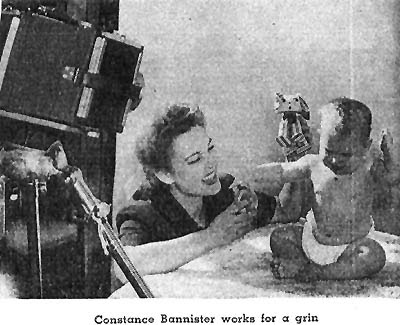
Comic Strip Features Cute Baby Photos
By Helen M. Staunton (E&P, 12/14/46)
Because Constance Bannister was never satisfied to take only one picture of a baby but "had to take about 50 pictures," she originated a unique feature that has achieved considerable acceptance in daily newspapers and special use in Sunday roto sections--a photographed "comic strip" of incidents in babies' lives.
Her strips, syndicated by Consolidated News Features, consist of four pictures of one or two babies in action with imaginary baby monologues in balloons. The formula is deceptively simple: In each a baby deals with some object or faces some problem and reacts, while Miss Bannister dubs in some baby comments with an unexpected twist. Perhaps one baby is confronted with another baby who's yelling, tries to soothe it, then asks, "Hey, Mom, should I slug her?"
The trick, says the baby photographer, is "to get the expressions to say the words. I frequently have to take 50 or more shots. It's always very difficult to start out with a positive idea.
"We get the thought-and give it a little leeway." She has been trying to get a good football sequence for some time she told E & P, "but hasn't been able to get the babies to do it yet " Now when she manages those pictures, they'll have
to go in the file for next season.
A professional baby photographer - and so photogenic herself that many of the papers using the feature have played her picture alongside the other babies - Constance Bannister has been persuading babies to grab a toe, look interested, point, make faces, etc., for years for a wide variety of magazine covers.
Then her own interest in seeing babies in more than one pose convinced her that a feature showing babies in successive poses ought to capture wide readership. A number of newspapers agreed. The New York Sun runs "Baby Banters by Bannister" as a twice-weekly strip. Other newspapers use it stripwise or as a full page in Sunday rotos. The Milwaukee Journal, which belongs to this group, made a local feature out of it not so long ago by running a local man's imitation with his baby granddaughter underneath it.
Tigers Fly Again
E&P, October 1946
If the first two weeks' continuity is a fair example, Bell Syndicate's new comic strip, "Flying Tigers", will have plenty of action, from street fights to intrigue to live tigers. Source of the material, chief character in the strip, and co-byliner is Capt. George (Pappy) Paxton, who was a member of one of the first groups to join the Flying Tigers, who served as a flight leader and member of Chennault's staff and who was shot down over the Burma Road in January 1942.
Charles Clarence Beck, a professional artist since the age of 15 and supervisor for three years of all comic magazine script preparation for the Anglo-American Publishing Co., is the artist. For 10 years he was a staff artist at Fawcett Publications, but for the past two years has headed with Peter Costanza a rapidly expanding art studio of their own. The strip is due for daily release soon.
New Feature
E&P, 1/18/47
A two-column weekly cartoon, "Oddities of Nature" is being offered by the A. S. Curtis Features Syndicate. The creator and author of this panel, Chuck Thorndike, has appeared in numerous newspapers in the United States and Canada and has written and illustrated 12 books. A veteran of both world wars, he had charge during the recent war of a department creating syndicated posters and visual materials.

Comic Strip Features Cute Baby Photos
By Helen M. Staunton (E&P, 12/14/46)
Because Constance Bannister was never satisfied to take only one picture of a baby but "had to take about 50 pictures," she originated a unique feature that has achieved considerable acceptance in daily newspapers and special use in Sunday roto sections--a photographed "comic strip" of incidents in babies' lives.
Her strips, syndicated by Consolidated News Features, consist of four pictures of one or two babies in action with imaginary baby monologues in balloons. The formula is deceptively simple: In each a baby deals with some object or faces some problem and reacts, while Miss Bannister dubs in some baby comments with an unexpected twist. Perhaps one baby is confronted with another baby who's yelling, tries to soothe it, then asks, "Hey, Mom, should I slug her?"
The trick, says the baby photographer, is "to get the expressions to say the words. I frequently have to take 50 or more shots. It's always very difficult to start out with a positive idea.
"We get the thought-and give it a little leeway." She has been trying to get a good football sequence for some time she told E & P, "but hasn't been able to get the babies to do it yet " Now when she manages those pictures, they'll have
to go in the file for next season.
A professional baby photographer - and so photogenic herself that many of the papers using the feature have played her picture alongside the other babies - Constance Bannister has been persuading babies to grab a toe, look interested, point, make faces, etc., for years for a wide variety of magazine covers.
Then her own interest in seeing babies in more than one pose convinced her that a feature showing babies in successive poses ought to capture wide readership. A number of newspapers agreed. The New York Sun runs "Baby Banters by Bannister" as a twice-weekly strip. Other newspapers use it stripwise or as a full page in Sunday rotos. The Milwaukee Journal, which belongs to this group, made a local feature out of it not so long ago by running a local man's imitation with his baby granddaughter underneath it.
Comments:
C.C. Beck never mentioned this strip as far as I know, but I will try and alert the Peter Hamerlinck at Alter Ego's FCA, which is all about Beck and Costanza and Fawcett and their Captain Marvel. They also have a column by Marc Swayze, who drew Flying Jenny for whoeever's name was on that and was wroking at the Beck/Costanza studio at that point, as far as I can remember.
Alan,
Paul (not Peter) Hamerlinck wrote back to me to say the Flying Tigers strip was once mentioned in a 1960's interview, but never again. He reckons it was one of many newspaper tries that didn't eh... fly.
Personally I'd love to get into those syndicate drawers and get all newspaper try-outs out of their files. Especially from the late fifties when ever comic artist out of a job tried to get into the papers. Someone shoudl go out and try to interview the surviving editors...
Paul (not Peter) Hamerlinck wrote back to me to say the Flying Tigers strip was once mentioned in a 1960's interview, but never again. He reckons it was one of many newspaper tries that didn't eh... fly.
Personally I'd love to get into those syndicate drawers and get all newspaper try-outs out of their files. Especially from the late fifties when ever comic artist out of a job tried to get into the papers. Someone shoudl go out and try to interview the surviving editors...
Thanks for checking, Ger. I was afraid that would be the case.
I used to own two big boxes of CC Beck's files, containing all sorts of interesting stuff, but I never saw anything about Flying Tigers in there either.
As for interviewing syndicate editors, I think that's a fantastic idea. I'd definitely not be one to do it, though, as I'd want to grill them like they were hostile witnesses!
--Allan
I used to own two big boxes of CC Beck's files, containing all sorts of interesting stuff, but I never saw anything about Flying Tigers in there either.
As for interviewing syndicate editors, I think that's a fantastic idea. I'd definitely not be one to do it, though, as I'd want to grill them like they were hostile witnesses!
--Allan
So if you had a box of CC Beck's stuff, I guess you know about the FCA and they know about the box and where it went to?
By the way, Paul is now preparing an article about the Captain Tootsie ads, which will include some of the daily Captain Toosie tiers I have found in a mid fifties paper. Did you ever come across that ad strip and do you have any dates on those?
Ger - Regarding CCB's files, I traded them along with a few Beck originals to a guy who was (he said) the biggest collector/expert on Beck in the country. Don't recall the fellow's name, but he seemed to really know his Beck.
I traded all that stuff for a really great Boots and her Buddies and a couple Out Our Way originals.
--Allan
I traded all that stuff for a really great Boots and her Buddies and a couple Out Our Way originals.
--Allan
Regarding Captain Tootsie, I don't track ad strips for Stripper's Guide. I know it ran at least 1946-48 as a Sunday color ad strip, but that's just based on a few clippings that I saved for my files.
--Allan
Post a Comment
--Allan
Monday, February 05, 2007
News of Yore: Strip Continuity
Syndicate Policies Vary On Continuity
By Helen M. Staunton (E&P, 1/25/47)
To the syndicate the carryover of comic strip fans from daily to Sunday or Sunday to daily is an important consideration, especially in these competitive days when one syndicate's sale is another syndicate's cancellation. Syndicate policy on handling continuity from daily to Sunday varies greatly, and each has good reasons for its conduct of the comic's plot.
Activities Varied
McClure's "Superman" may swoop out of windows and bait bank robbers each weekday, aid a veteran in successive Saturday colored pages (huh?) and carry on a third episodic story Sundays. McNaught's "Joe Palooka" carries on two continuities, one along personal lines and the other not far from the prize ring. AP Newsfeatures' "Scorchy Smith" works hard at adventures during the week, but pauses Sunday for a timeless gag incident. The Chicago Tribune-New York News Syndicate's "Dick Tracy" rushes madly about town or suffers under impending dooms during the week, but his problems come to a head Sundays.
Even the gag strips, which use little or no continuity, frequently change their characters for Sunday, but when they do the reason is the desire to appeal to younger readers. The diversity of syndicate practice is in the continuity comics, not in their humorous comics.
In the CT-NYNS list of comics "Dick Tracy" "Terry and the Pirates" and "Little Orphan Annie" of the continuity strips, use a single continuity for the whole week, but the "Gumps" and "Gasoline Alley" do not. The reason? Some artists have a flair for keeping a plot moving with the single and necessarily overlapping continuity, and some prefer to handle only a .single plot.
King Features - with a very few exceptions - does not coordinate daily and Sunday plots because so frequently the daily and Sunday comics are published by different newspapers and "because readers have become educated" to dual plots, according to Editor and General Manager Ward Greene. For good measure he threw in also the shipping problems in sending the daily and Sunday separately to foreign countries. "Steve Canyon," however, "Little Annie Rooney" and (recently and experimentally) "Buz Sawyer," have carried the one plot past the turn of the week. Other syndicates expressed their policies and reasons variously:
United Feature Syndicate- separate action preferred because daily and Sunday placed separately and "continuity of characters is more important as a tie-in than single plot."
McNaught - separate plots or action because the syndicate may sell dally and Sunday to different papers in same city and because artists, preparing Sunday pages eight or nine weeks in advance, find coordination difficult.
AP Newsfeatures - prefer daily continuity separate from Sunday action, but don't like a Sunday continuity to run more than three or four weeks and prefer it complete in one page because the "week's time lapse is too great" for a holdover of story interest.
Register & Tribune Syndicate - Single continuity is a pretty definite policy, arranged so that the Saturday story reads into the Sunday and also reads into the Monday strip, the Sunday action being an independent incident growing out of the main plot but not necessary to it and not requiring explanation.
Chicago Sun Syndicate - coordinated plot preferred, particularly on an adventure strip to avoid reader confusion and aid selling.
McClure - Separate plots for Superman, coordinated plot for ' Cynthia," using a side incident of main plot, because "Cynthia" is a true to life story and a double continuity would sacrifice authenticity.
NEA Service - No set policy. Four features have coordinated continuity and one, "Alley Oop" changed over to a single story some months ago.
George Matthew Adams Service - No coordination.
By Helen M. Staunton (E&P, 1/25/47)
To the syndicate the carryover of comic strip fans from daily to Sunday or Sunday to daily is an important consideration, especially in these competitive days when one syndicate's sale is another syndicate's cancellation. Syndicate policy on handling continuity from daily to Sunday varies greatly, and each has good reasons for its conduct of the comic's plot.
Activities Varied
McClure's "Superman" may swoop out of windows and bait bank robbers each weekday, aid a veteran in successive Saturday colored pages (huh?) and carry on a third episodic story Sundays. McNaught's "Joe Palooka" carries on two continuities, one along personal lines and the other not far from the prize ring. AP Newsfeatures' "Scorchy Smith" works hard at adventures during the week, but pauses Sunday for a timeless gag incident. The Chicago Tribune-New York News Syndicate's "Dick Tracy" rushes madly about town or suffers under impending dooms during the week, but his problems come to a head Sundays.
Even the gag strips, which use little or no continuity, frequently change their characters for Sunday, but when they do the reason is the desire to appeal to younger readers. The diversity of syndicate practice is in the continuity comics, not in their humorous comics.
In the CT-NYNS list of comics "Dick Tracy" "Terry and the Pirates" and "Little Orphan Annie" of the continuity strips, use a single continuity for the whole week, but the "Gumps" and "Gasoline Alley" do not. The reason? Some artists have a flair for keeping a plot moving with the single and necessarily overlapping continuity, and some prefer to handle only a .single plot.
King Features - with a very few exceptions - does not coordinate daily and Sunday plots because so frequently the daily and Sunday comics are published by different newspapers and "because readers have become educated" to dual plots, according to Editor and General Manager Ward Greene. For good measure he threw in also the shipping problems in sending the daily and Sunday separately to foreign countries. "Steve Canyon," however, "Little Annie Rooney" and (recently and experimentally) "Buz Sawyer," have carried the one plot past the turn of the week. Other syndicates expressed their policies and reasons variously:
United Feature Syndicate- separate action preferred because daily and Sunday placed separately and "continuity of characters is more important as a tie-in than single plot."
McNaught - separate plots or action because the syndicate may sell dally and Sunday to different papers in same city and because artists, preparing Sunday pages eight or nine weeks in advance, find coordination difficult.
AP Newsfeatures - prefer daily continuity separate from Sunday action, but don't like a Sunday continuity to run more than three or four weeks and prefer it complete in one page because the "week's time lapse is too great" for a holdover of story interest.
Register & Tribune Syndicate - Single continuity is a pretty definite policy, arranged so that the Saturday story reads into the Sunday and also reads into the Monday strip, the Sunday action being an independent incident growing out of the main plot but not necessary to it and not requiring explanation.
Chicago Sun Syndicate - coordinated plot preferred, particularly on an adventure strip to avoid reader confusion and aid selling.
McClure - Separate plots for Superman, coordinated plot for ' Cynthia," using a side incident of main plot, because "Cynthia" is a true to life story and a double continuity would sacrifice authenticity.
NEA Service - No set policy. Four features have coordinated continuity and one, "Alley Oop" changed over to a single story some months ago.
George Matthew Adams Service - No coordination.
Labels: News of Yore
Comments:
It seems to be a bit of a put-down when she says "some artists have a flair", implying others do not.
Especially when in that same paragraph it is Frank King who is one of those who do not have the flair.
His Sunday pages, independent of daily continuity, were works of art with a self-contained artistic continuity that must have taken hours longer to create than if he had simply continued the daily storyline.
Post a Comment
Especially when in that same paragraph it is Frank King who is one of those who do not have the flair.
His Sunday pages, independent of daily continuity, were works of art with a self-contained artistic continuity that must have taken hours longer to create than if he had simply continued the daily storyline.
Sunday, February 04, 2007
Obscurity of the Day: Little Julius Sneezer


 In one of World Color Printing's brief forays into the daily comic strip business, Little Julius Sneezer was produced from April 30 through at least September 1917. The art on the strip was pretty awful, in fact it bears strong indications that it was created mostly from pasted-up model sheet poses. Note the similarities of Little Julius' poses from strip to strip.
In one of World Color Printing's brief forays into the daily comic strip business, Little Julius Sneezer was produced from April 30 through at least September 1917. The art on the strip was pretty awful, in fact it bears strong indications that it was created mostly from pasted-up model sheet poses. Note the similarities of Little Julius' poses from strip to strip.The gags, on the other hand, were often pretty snappy, using the latest slang and patter. In fact, in my reading of the strip I get a funny feeling that the cartoonist, a Mr. Baker, might well have been going to vaudeville houses and taking notes on the comedians. On strips 2 and 3 above try reading the patter supplying the voices of Groucho and Chico Marx. Not that these are necessarily Marx Brothers routines, but there were plenty of comedy teams at the time, I imagine, that would have been using this sort of off-the-wall stage patter.
Though Little Julius Sneezer had a relatively short run, World Color Printing really got their money's worth out of it. They continued to sell the strip in bulk lots to small papers for years, and also reused the strip in their Sunday children's activity pages from March 29 1925 to January 17 1926. Then the rights to the strip were sold to the International Cartoon Company, and these folks, the kings of the cheap reprint service, distributed plates of the strips to small papers for years. I have a sample of these plates and here is the label from the back that gives a snapshot of their business model:
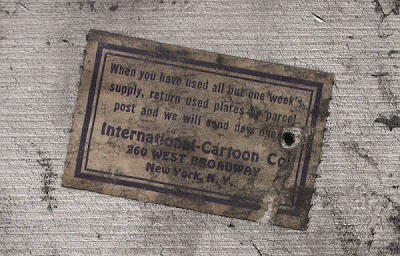
EDIT: Alex Jay has since sleuthed out the identity of Mr. Baker. It is George M. Baker, but not the George Baker who created the long-running comic strip and comic book character Sad Sack.
Labels: Obscurities
Comments:
The redistribution process of "Julius Sneezer" in the 1920s and so on reminds me of how cheapo-movie distributors distributed old cartoons with chopped up titles to early television markets. I guess even comic strips wern't safe from this process.
Do you know any other comics that International Cartoon Company distributed?
Do you know any other comics that International Cartoon Company distributed?
Check this post for some more:
http://strippersguide.blogspot.com/2005/11/perennial-reprint-comic-strips.html
Post a Comment
http://strippersguide.blogspot.com/2005/11/perennial-reprint-comic-strips.html
Saturday, February 03, 2007
Jim Ivey's Photo Album, Part Five
One last look at Jim Ivey's photo album today. If you'd like to see a great selection of Jim's cartoons you are in luck. Robin Snyder's magazine "The Comics - The Original First Person History" starts publishing a retrospective of Jim Ivey's cartoons in the current issue, with the cartoons personally chosen by Ivey along with his commentary. You can subscribe to "The Comics", which apparently does not have a website, by sending $28 ($35 foreign) for a 12-issue subscription to:
Robin Snyder
3745 Canterbury Ln #81
Bellingham WA 98225-1186
To be safe you might mention that you wish to start your sub with the first Ivey issue, but it is the current issue as this is written. And Snyder's publication is well worth the small price, as it features all sorts of really interesting material from all genres and phases of cartooning history. Highly recommended.
Robin Snyder
3745 Canterbury Ln #81
Bellingham WA 98225-1186
To be safe you might mention that you wish to start your sub with the first Ivey issue, but it is the current issue as this is written. And Snyder's publication is well worth the small price, as it features all sorts of really interesting material from all genres and phases of cartooning history. Highly recommended.
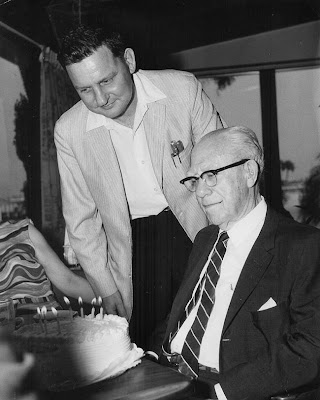 Jim Ivey throws a birthday party for Frank King in 1968. Unfortunately invisible in this photo is that the cake is decorated with an image of Skeezix. Frank wonders which one of his assistants is responsible for the bad likeness.
Jim Ivey throws a birthday party for Frank King in 1968. Unfortunately invisible in this photo is that the cake is decorated with an image of Skeezix. Frank wonders which one of his assistants is responsible for the bad likeness.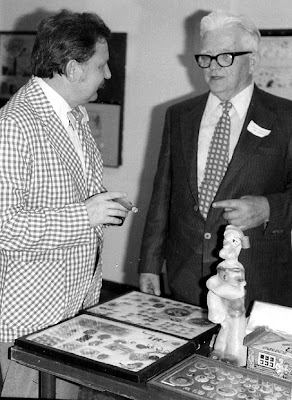 Cartoonist Dick Hodgins Sr., who was for awhile assistant curator of the Cartoon Museum, at the grand re-opening in 1974. Dick is apologizing for only wearing the tie from his Cartoon Museum uniform.
Cartoonist Dick Hodgins Sr., who was for awhile assistant curator of the Cartoon Museum, at the grand re-opening in 1974. Dick is apologizing for only wearing the tie from his Cartoon Museum uniform. 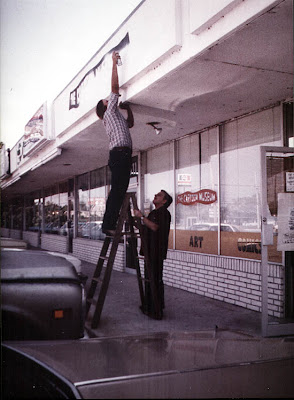 The Cartoon Museum's Bull Plaza location being shut down in 1981. The Museum would reopen in south Orlando at Weatherford Square.
The Cartoon Museum's Bull Plaza location being shut down in 1981. The Museum would reopen in south Orlando at Weatherford Square. C.C. Beck enjoying libations at the open bar at Orlandocon 1979. And you thought the cartoonists flocked to O'Con for the panel discussions.
C.C. Beck enjoying libations at the open bar at Orlandocon 1979. And you thought the cartoonists flocked to O'Con for the panel discussions.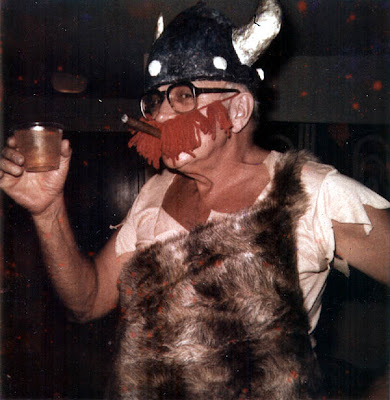 Fred Lasswell is asked to accept Dik Browne's Ignatz Award at Orlandocon when Dik couldn't make it. Fred just happens to have this costume with him.
Fred Lasswell is asked to accept Dik Browne's Ignatz Award at Orlandocon when Dik couldn't make it. Fred just happens to have this costume with him.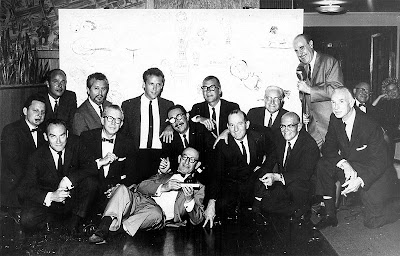 A cartoonist get-together at the San Francisco Press Club in 1964. Top row, John Holm, Gus Arriola, Lee Holley, Frank O'Neal, unknown, Darrell McClure. Second row, Jim Ivey, unknown, unknown, Bob Barnes, unknown, Jimmy Hatlo. In front Tack Knight.
A cartoonist get-together at the San Francisco Press Club in 1964. Top row, John Holm, Gus Arriola, Lee Holley, Frank O'Neal, unknown, Darrell McClure. Second row, Jim Ivey, unknown, unknown, Bob Barnes, unknown, Jimmy Hatlo. In front Tack Knight.
The king in his castle, 1976.
Labels: Jim Ivey's Photo Album
Friday, February 02, 2007
Jim Ivey's Photo Album, Part Four
More from Jim Ivey's photo album:
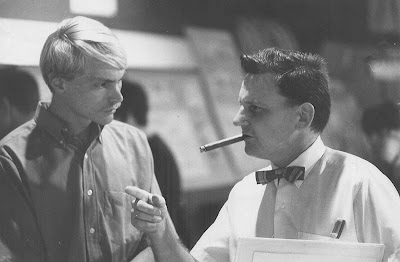 Jim shares some words of wisdom and encouragement with an aspiring cartoonist at the grand opening of the Cartoon Museum in 1967. A scene that was replayed thousands of times over the years (and no, not just with this guy).
Jim shares some words of wisdom and encouragement with an aspiring cartoonist at the grand opening of the Cartoon Museum in 1967. A scene that was replayed thousands of times over the years (and no, not just with this guy).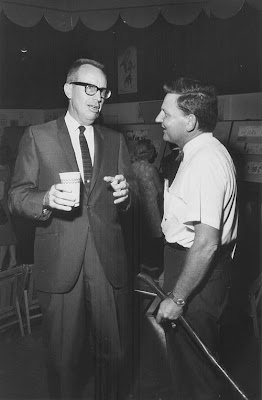 St. Petersburg Times cartoonist and writer Dick Bothwell with Jim at the 1967 grand opening. Jim speaks softly but carries a big stick. That stick, by the way, was carved by McKee Barclay of the Baltimore Sun and features caricatures of political figures.
St. Petersburg Times cartoonist and writer Dick Bothwell with Jim at the 1967 grand opening. Jim speaks softly but carries a big stick. That stick, by the way, was carved by McKee Barclay of the Baltimore Sun and features caricatures of political figures.
Jim and Dick Hodgins Sr. compare sizes at the Cartoon Museum in 1977. Yeah right, Dick.
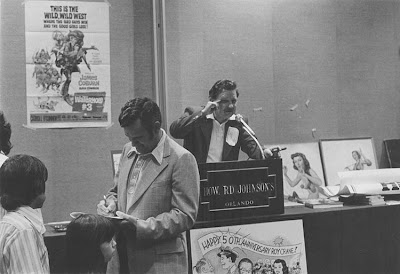 Disney artist Ralph Kent (foreground) being introduced by Ivey at the 1974 Orlandocon. Kent fights his way through autograph seekers to get to the lectern. He swears they're not his kids.
Disney artist Ralph Kent (foreground) being introduced by Ivey at the 1974 Orlandocon. Kent fights his way through autograph seekers to get to the lectern. He swears they're not his kids.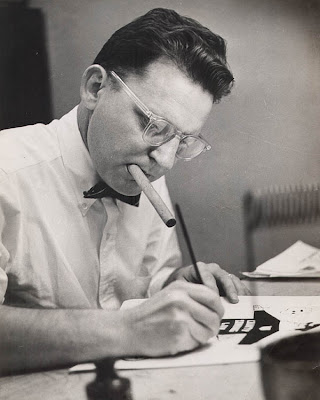
Ivey publicity photo from the St. Petersburg Times circa 1955. Jim was worked like a dog there in his first years, producing a paper that seemed to have an Ivey spot drawing or cartoon on every page. Poor guy didn't even have time to light his cigar.
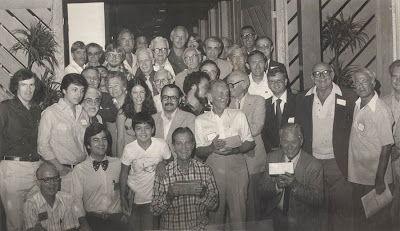 Group portrait at Orlandocon 1979. You've already been introduced to a lot of these folks, a few you haven't are Fred Wagner at extreme left, actors Bob Cummings and Kirby "Sky King" Grant crouched in front holding Ignatz bricks, and caricaturist Jack Rosen (father of hotelier Harris Rosen) far right holding paper.
Group portrait at Orlandocon 1979. You've already been introduced to a lot of these folks, a few you haven't are Fred Wagner at extreme left, actors Bob Cummings and Kirby "Sky King" Grant crouched in front holding Ignatz bricks, and caricaturist Jack Rosen (father of hotelier Harris Rosen) far right holding paper. Washington Post editorial cartoonist Herblock pays a visit to Jim at the St. Petersburg Times in 1958. Ivey sports a pompadour that was, thankfully, not a long term choice.
Washington Post editorial cartoonist Herblock pays a visit to Jim at the St. Petersburg Times in 1958. Ivey sports a pompadour that was, thankfully, not a long term choice.
Jim Ivey gets shafted on meeting Satchmo. Louis Armstrong visits the St. Petersburg Times in 1956 to be presented with an Ivey caricature, but Jim was on assignment at the state capital that day, so cartoonist Arnie Mossler presents the piece to the jazz legend.
Labels: Jim Ivey's Photo Album
Thursday, February 01, 2007
Jim Ivey's Photo Album, Part Three
More from Jim Ivey's photo album:
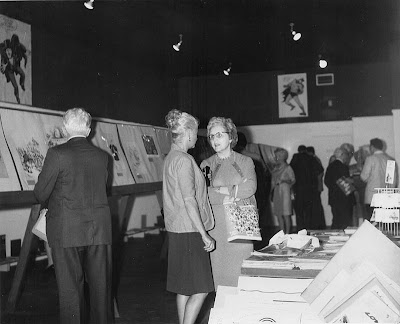
Mrs. Bill Crooks and Mrs. Leslie Turner abandoned at the Cartoon Museum in 1968. Off commiserating in the corner are Jim, Frank King, Dick Moores, Les Turner and the ladies' husbands.

Jim Ivey has an audience with one of his idols, Rube Goldberg (the dapper gent in the center) in 1961. Also basking in the Goldberg presence are Tack Knight and Bert Whitman. Bert is the fellow on the right, who need never worry about anyone making fun of his plaid jacket.
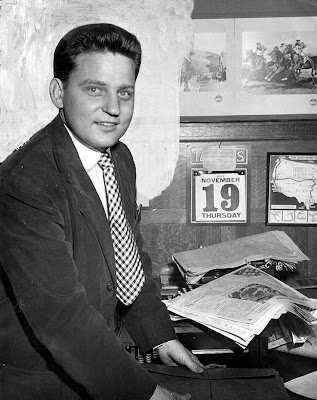
Jim on his last day at the Washington Star, 1953. He's off to St. Petersburg to become editorial cartoonist of the Times.
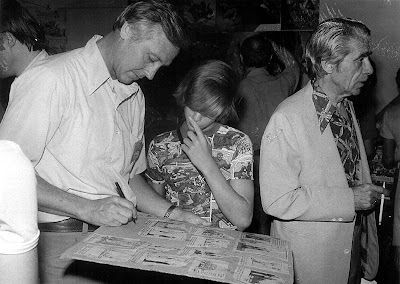
Ralph Dunagin has a very unexpected fan encounter at Orlandocon 1977 -- the kid in the Spider-man shirt has brought a selection of Dunagin's People cartoons for him to autograph. Edmund Good, right, wonders where the Scorchy Smith fans are all hiding.
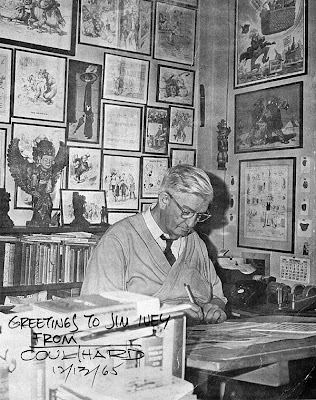 Jim Ivey's buddy from his San Francisco days, the excellent cartoonist and art collector John Coulthard. Behind John you can see a small sampling of the treasure trove of originals he owned.
Jim Ivey's buddy from his San Francisco days, the excellent cartoonist and art collector John Coulthard. Behind John you can see a small sampling of the treasure trove of originals he owned.
 Jim Ivey is interviewed on television in 1975. The wonders of pancake make-up...
Jim Ivey is interviewed on television in 1975. The wonders of pancake make-up...
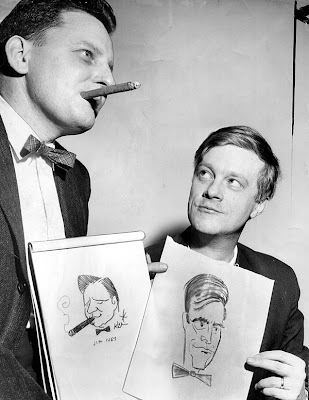 Finnish cartoonist Kari Suomalanien visits Jim in San Francisco in 1960. Looks to me like Kari may be sending a subtle signal that he's not fond of his caricature. Note his left hand.
Finnish cartoonist Kari Suomalanien visits Jim in San Francisco in 1960. Looks to me like Kari may be sending a subtle signal that he's not fond of his caricature. Note his left hand.
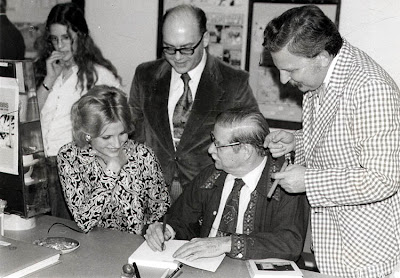
Roy Crane makes a book-signing appearance at the grand reopening of the Cartoon Museum in 1974 (it moved from Madeira Beach to the Crealde Art Center in Winter Park). Crane is making some time with a gorgerous babe until...

...the lady sees Jim's sonic boom of a jacket and the mood is ruined.
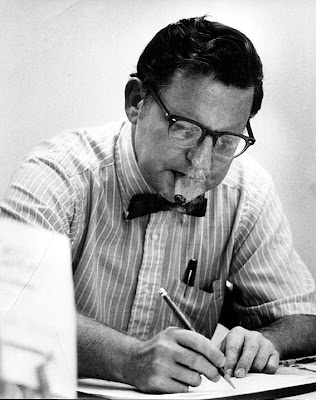 Jim Ivey when he joined the Orlando Sentinel in 1970, trying to think up Orlando editorial cartoon ideas before Disney arrived and made it easy.
Jim Ivey when he joined the Orlando Sentinel in 1970, trying to think up Orlando editorial cartoon ideas before Disney arrived and made it easy.




 Jim Ivey's buddy from his San Francisco days, the excellent cartoonist and art collector John Coulthard. Behind John you can see a small sampling of the treasure trove of originals he owned.
Jim Ivey's buddy from his San Francisco days, the excellent cartoonist and art collector John Coulthard. Behind John you can see a small sampling of the treasure trove of originals he owned. Jim Ivey is interviewed on television in 1975. The wonders of pancake make-up...
Jim Ivey is interviewed on television in 1975. The wonders of pancake make-up... Finnish cartoonist Kari Suomalanien visits Jim in San Francisco in 1960. Looks to me like Kari may be sending a subtle signal that he's not fond of his caricature. Note his left hand.
Finnish cartoonist Kari Suomalanien visits Jim in San Francisco in 1960. Looks to me like Kari may be sending a subtle signal that he's not fond of his caricature. Note his left hand.

 Jim Ivey when he joined the Orlando Sentinel in 1970, trying to think up Orlando editorial cartoon ideas before Disney arrived and made it easy.
Jim Ivey when he joined the Orlando Sentinel in 1970, trying to think up Orlando editorial cartoon ideas before Disney arrived and made it easy.Labels: Jim Ivey's Photo Album
Comments:
It's all Jim Ivey's fault I tell ya. About 30 years ago I got his Wash Tubbs book, ever since I have been a sincere believer the Roy Crane's Captain Easy is the best adventure strip ever! No, I cannot be dissuaded; and it's all Jim Ivey's doing!
These are absolutely terrific Allan ---many thanks for posting them. I especially appreciate those that have pertained to caricature, caricaturists ---an art form of foremost interest not only to Jim but myself as well.
Hope you'll be sharing more.....
Side note: Jim & i both worked at the old S.F. Examiner, albeit 25 years or so apart.
It was there (while on staff as an illustrator) that i first discovered his work, the impact of which lead to many an hour (& on the Examiner's dime naturally ;-) ) down in the paper's archives making copious copies of his caricatures & political cartoons so that i could develop a nice collection of them to admire & learn from.....
Post a Comment
Hope you'll be sharing more.....
Side note: Jim & i both worked at the old S.F. Examiner, albeit 25 years or so apart.
It was there (while on staff as an illustrator) that i first discovered his work, the impact of which lead to many an hour (& on the Examiner's dime naturally ;-) ) down in the paper's archives making copious copies of his caricatures & political cartoons so that i could develop a nice collection of them to admire & learn from.....


